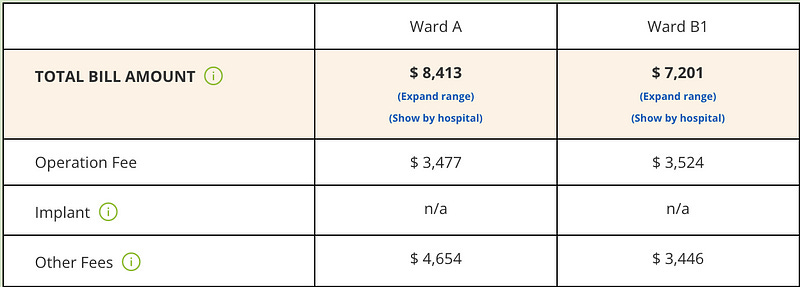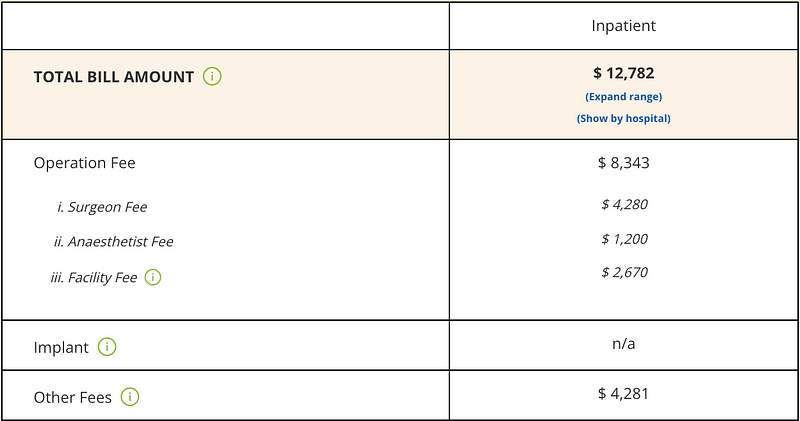The cost of giving birth in Singapore
From ob-gyn visits to giving birth, how much does it actually cost?

Do note that figures and content are relevant at the time when this article was written in 2022.
In this article, we will predominantly be exploring the common costs incurred through the process of pregnancy to giving birth in Singapore as well as the potential subsidies you would be eligible to receive_._ It is also written under the assumption that it is discovered in the 5th week of the pregnancy (when it’s commonly discovered)
We hope that this article gives those who eventually want to have a family an idea of the approximate costs and mentally prepare themselves financially for such milestones. Moreover, when we tried to come up with a separate article on the cost of having a child in Singapore, we were unable to find relevant information on it and hope to serve as a solution to that.
Let’s face it, when it comes to pregnancy there’s plenty to make decisions on from choosing the right hospital and obstetrician — whether it’s in a public or private hospital to the different care units and delivery procedures you may opt for. As such, we will also be discussing the varying costs through each stage of pregnancy (antenatal/pre-natal, giving birth to postnatal).
If you are reading this because you are expecting your first child, a big congratulations! And if you are reading it as a couple planning ahead in time, we hope that you find this article useful. It’s a beautiful time worth celebrating and you would definitely want to be as prepared for it as you can be!
1. Finding out you are pregnant
Upon discovering you are pregnant with an over-the-counter pregnancy test kit, the next thing you would want to do is to book an appointment with an obstetrician. This can be done at a Polyclinic (thereafter a referral to a specialist in KKH), General Practitioner, or private clinic/hospital.
The big main question one will need to decide on is — private or public healthcare.
Private vs public healthcare
The main difference between the two different routes is in the costs and choice of obstetricians. Of course, also the experiential aspect that each hospital would differentiate itself from others and market heavily to soon-to-be mums.
(i) Overview: Choosing Private Healthcare
-
There are _no subsidie_s given.
-
You can choose an obstetrician and one that will follow you from your first visit until you deliver your baby and even post-natal visits. You will also have a direct point of contact who is your doctor if you were to face any issues.
This seems to be a large factor as to why people opt for private healthcare as the journey can be an intimate one and it allows you to build a good relationship with your doctor(s), making it more comfortable to ask any questions. They’ll also be up to speed on your condition since your last visit, so there’s no need to explain things a second time.
- The wards and hospital stay during post-birth are known to be a huge plus point with some hospitals offering extra services such as massages and special postnatal meals.
(ii) Overview: Choosing Public Healthcare/Government hospital
-
You are eligible for subsidies.
-
You will not be able to choose a specific obstetrician of your choice. However, you will be cared for by a team of doctors led by a consultant obstetrician.
Please read on as we highlight how much more affordable subsidised care is. As for the experiential aspect, although you are likely to see a different doctor each time you go for your antenatal care and you may not get your obstetrician of choice for the delivery of your baby, there would always be a consultant in charge of your care at all times.
Do note that only Singapore residents and PRs are eligible for the subsidies. More on that later down below!
2. Your first appointment
During your first appointment with the obstetrician, the series of tests will usually revolve around confirming your pregnancy, understanding how far into the pregnancy you are, and even getting an estimated delivery due date (EDD)! This will include processes such as a blood test for Human Chorionic Gonadotropin (HCG), pelvic exams, and vaginal ultrasound.
Consultation fee:
Cost: Subsidised fee at a Public hospital (eg: Polyclinic to KKH referral)
$29.40
(Do note that in order for your public hospital fees to be subsidised you would need to go through a referral from the Polyclinic/GP)
Cost: Private Healthcare route
$143.38
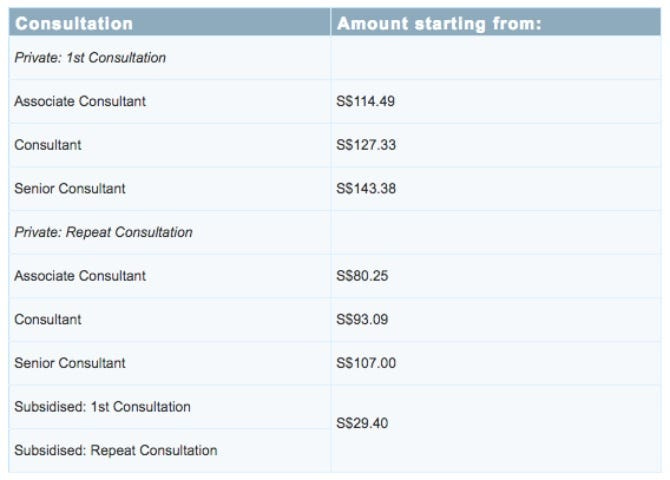
Image source: Theasianparent
The total cost of your first visit:

Cost: Subsidised fee at a Public hospital (eg: Polyclinic to KKH referral)
$800
Cost: Private Healthcare route
$2,216
3. Pregnancy period
During the entire course of your pregnancy, you will have an estimate of about 8-10 consultations with your obstetrician. Of course, this would depend on when you start visiting the doctor and how you (and your baby) are faring in the process.
A regular consultation schedule looks as such:

Source: Singapore National Health Group
Alongside that, you may take various tests and checks that would be offered to you to ensure a smooth journey for both you and the growth of your child.
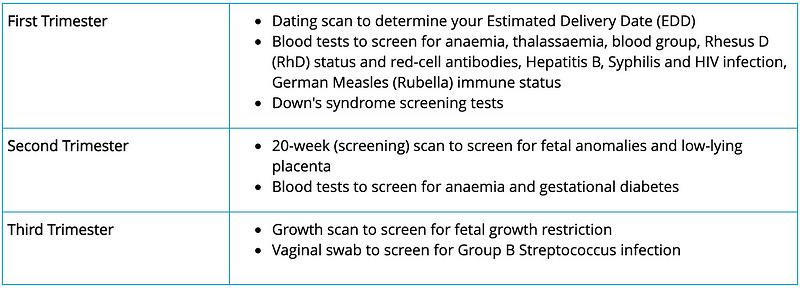
Source: KKH Singapore
The average costs for some of the prenatal care tests and miscellaneous items you would be taking throughout your pregnancy are listed here:

source: Pacific Prime
3.1 First Trimester
Let’s break things down to each trimester— the first trimester. This is when things are most crucial and many tests are done to ensure the safe growth of your baby. It is also said that these tests are best done early for their accuracy.
On top of the regular standard consultation charge and blood test incurred with each visit, you may also consider getting additional tests done. During your pregnancy, you will be offered routine scans and tests to check for certain conditions. Your doctor will explain the purpose of any tests you are offered. It is important to keep in mind that no test offered is 100% accurate or mandatory and is on an opt-in basis.

Something to note is that the total costs here may be more than what one may spend as you may not take every test that is included. (Also, the term “antenatal” and “prenatal” is used interchangeably as different hospitals use different terms… )
Packages
Alternative to the individual price breakdown, some hospitals offer antenatal packages (also known as prenatal packages) that you may opt for to cover the basic essential processes & costs of the first trimester. Do note that there are no packages offered for subsidised public hospitals, instead, subsidised consultation fees will be charged per session.
This is one offered by KKH Singapore:

Source: KKH Singapore
You may consider taking up such packages and thereafter opt for and pay for other tests and procedures additionally above it.
Approximate first-trimester cost
Cost: Public Healthcare route (non-package)
From $1,021
Cost: Private Healthcare route (non-package)
From $2,754
3.2 Second and Third Trimester
In your second trimester (week 13 onwards), you would be estimated to have 6 consultation sessions. Above that, there would be various tests and two important vaccinations that your doctor will strongly advise you to have during pregnancy, to protect your baby, as well as yourself.
Below is a summary of tests and vaccinations you will take on during the two trimesters:

Source: KKH Singapore
Similar to the first trimester, you may consider signing up for a relevant package offered by your hospital / your obstetrician. This would include check-ups escalating to weekly ones in your final trimester.
The package fees and coverage will differ depending on the gynaecologist you visit. On average, you can expect to pay from $738 for subsidised hospitals and from $1,500 for private hospitals.
Something to note is, you can opt to pay a per-visit rate if you prefer, or are unsure if you may still want to use a different gynaecologist. To convince you to buy the package and stick with them, most gynaecologists will price the package such that it makes more financial sense to opt for package.
Here is one offered by KKH(subsidised):

Source: KKH Singapore
Approximate second and third-trimester cost
Cost: Subsidised Healthcare route
From $738 (package price)
Cost: Private Healthcare route
From $1,500(package price)
4. Delivery and your hospital stay
The main bulk of the pregnancy costs would be incurred during this period. After all, it is the moment when you would finally get to meet your child after the long wait and also where birth complications may arise.
The cost of delivery varies greatly with the delivery procedure — if it’s natural or caesarian birth. Natural birth will (no pun intended) naturally, be a simpler procedure and thus be the more affordable option. However, do note that emergency caesarian is also common. In fact, 18.2% of all births were reported to be emergency caesarian sections by the National Library of Medicine. Other matters that would affect the cost include assisted birth, use of epidurals/anesthetics, and the compulsory length of and choice of the ward during the hospital stay thereafter.
Natural Birth (Public Hospital): For natural birth, you are likely to stay at the hospital an average of 24–36 hours after the procedure. If you are opting for a natural birth at a public hospital, you can expect the cost of delivering a baby to be relatively more affordable than if you choose private healthcare. The table below illustrated shows the range of cost if you were to opt for an A-Class ward which is expected to be about $4,799 to $5,141.

Source: MOH Singapore
If you’re looking for something more affordable, you may consider the Class B2/C wards at government-funded hospitals. You would be eligible for heavy subsidies of up to 80% which makes your hospital fees as low as $805 (NUH) if at ward C.
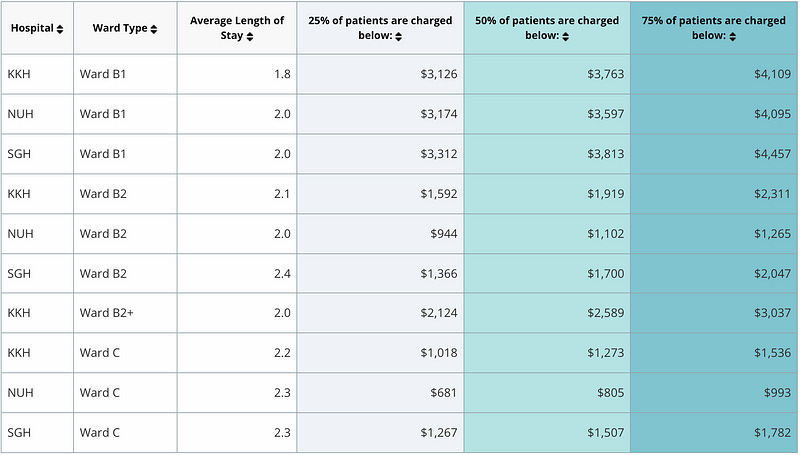
Source: MOH Singapore
Although it varies across each public hospital, here is a general guide to the description of the different public hospital ward classes:

Source: Singapore General Hospital
**Natural Birth (Private Hospital):
**If you opt to deliver at a private hospital, you can expect a higher hospital fee. For the ward types that give you the privacy of a single bed, the range is from $7,754 (Parkway East Hospital) to $10,495 (Gleneagles). About 10x more expensive than a C-ward in a subsidised public hospital
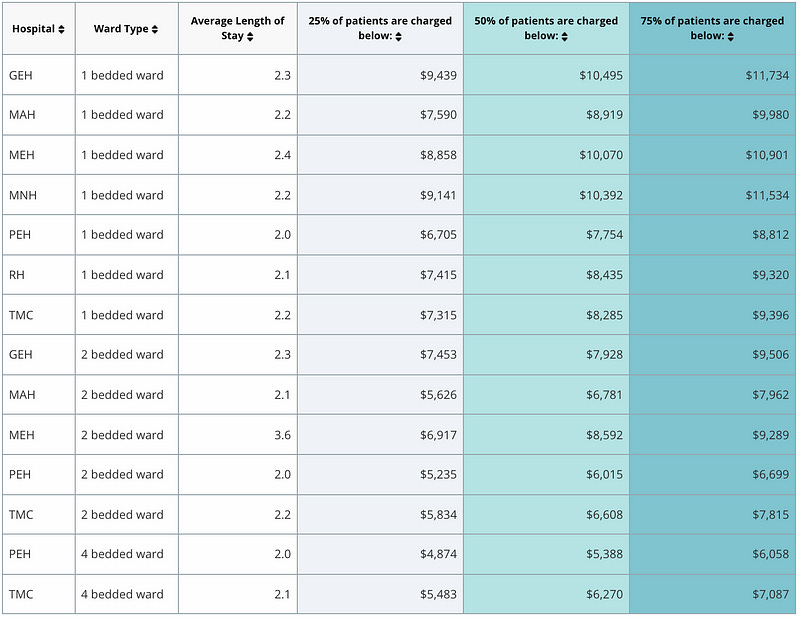
Source: MOH Singapore
- Caesarian Birth (Public Hospital):
As caesarean delivery is considered major surgery and incurs higher gynaecology fees, the overall fees would also be higher. Additionally, the recovery process would be slightly longer than that of natural birth with the post-birth hospital stay to be from 36–48 hours. All in all, just make a larger bill.
The table below illustrated shows the average cost (what 50% of the people were charged) if you were to opt for an A or B1 Class ward which is expected to be about $8,413 and $7,201 respectively.
- Caesarian Birth (Private Hospital):
As for doing a C-section in a private hospital, 50% of the people were charged a median cost of $12,782. Do note that this data is as accurate as of 2022, and you should consult your doctor for a more comprehensive and accurate cost.
Source: MOH Singapore
5. Medisave Maternity Package
After reading about the hefty costs to be incurred to the point of birth, you may be getting slightly lightheaded– I sure feel that way. Now, let’s lighten the mood and (potential) financial burden.
Under the MediSave Maternity Package, you can use your MediSave savings for the various stages of pregnancy from pre-delivery medical expenses (first to the third trimester), delivery expenses and daily hospital charges regardless of whether you choose to frequent a public or private hospital.
-
Pre-delivery expenses
You can withdraw up to $900 for pre-delivery medical expenses such as consultations, ultrasounds, medications, tests etc. -
**Delivery of baby
**The withdrawal amount differs with each MediSave Maternity Package (e.g. caesarean or vaginal delivery). It would range from $750 to $3,950. -
Daily hospitalisation charges
As for the hospitalisation charges, you can withdraw $550 for the first two days of hospitalisation and $400 per day thereafter.
You may refer to the infographic below:
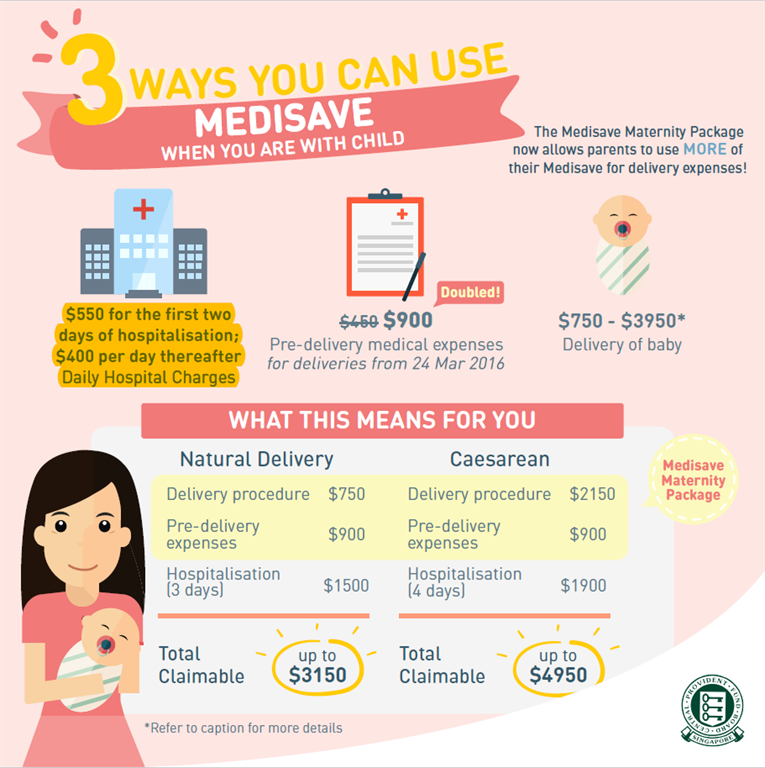
Source: CPF Board Singapore
6. Prenatal/Maternity Insurance
Another matter to consider is the many common health complications that can potentially arise, it’s only normal for one may feel a little anxious about the financial aspect.
Something you would want to consider is maternity insurance. (You can read an article we did here) It gives financial protection to both the mother and baby during and after* pregnancy. It would also cover the different aspects of your pregnancy through the various tests that you would go through and if any complications were to arise. Ultimately, it is to give you a financially stress-free process through each doctor’s visit through to delivery and post-birth. Let’s not forget that pregnancy is one that involves both the mum and the child and it’s always good to be prepared for what’s ahead.
*The duration of protection after birth varies with the insurer.
While there are many maternity insurances in the market, the bottom line is to get it as early as possible, at the 13th week of pregnancy (the start of the first trimester), and should cover you for the following things:
-
Hospitalisation benefit: Daily cash benefit for each day you (the mum)and the baby are hospitalised due to pregnancy complications
-
Protection in the event of pregnancy complications: Complications or congenital illnesses the newborn may have. (Example: congenital illnesses include Cerebral Palsy, Down’s Syndrome and congenital deafness)
-
Lump-sum payout upon death: In the event of death of yourself (the mum) or the child, you will receive a lump sum payout
-
**Guarantee insurance coverage for your newborn: This means that upon birth, your baby will get an insurance plan with the same insurer, without a medical check-up required. This is especially important as it protects your child from being rejected of insurance coverage and exclusions.
-
If you’re looking into specific processes such as conceiving through IVF or Caesarian delivery, look into the maternity plans that offer those features.
** Maternity Products such as the Mum2baby offered by AIA allow you to tie a whole life plan to a maternity plan so while the mum is pregnant this plan protects her but once the child is born, it is transferred to the newborn.
For more details on it, do reach out to our Financial Advisors here.
The cost of maternity insurance can range from $300 to $1,600, depending on the various coverage, and the age of the mother — the younger, the lower the premiums.
Conclusion
As the pregnancy process can differ greatly with so many different variables, it’s difficult to put a definite price on it. But here are some of the main factors that would determine the cost of it.
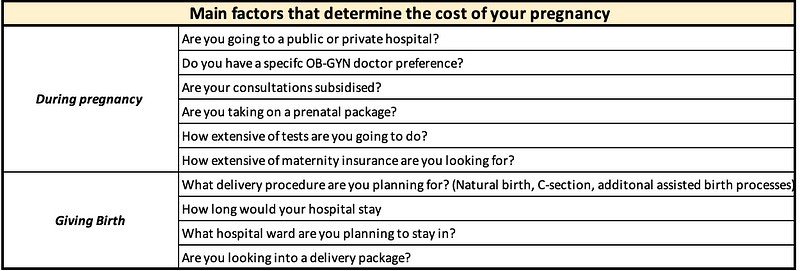
An important thing to note is as with many things in life, we may plan for it a certain way but it may pan out differently– especially so when we are talking about a bun in the oven! Be prepared for it financially and beyond so you can look forward to the day you are handed your baby in your arms with ease.

